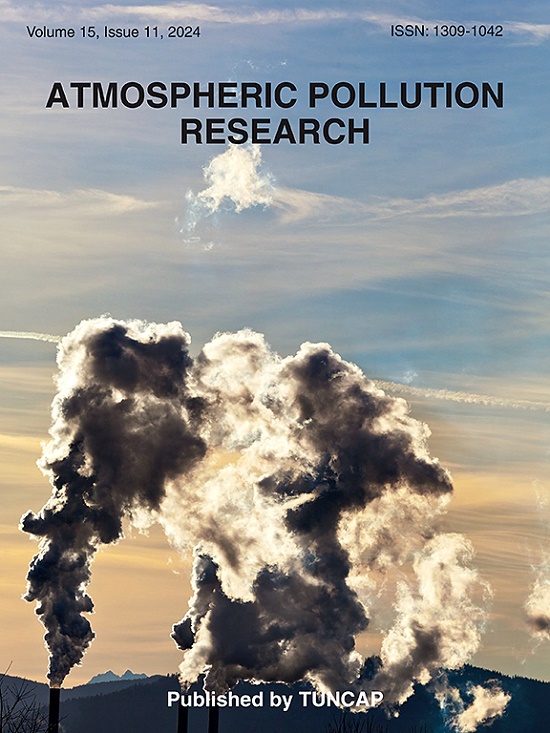Variations in the characteristics and sources of PM2.5 during the COVID-19 lockdown in Xiangyang, Hubei Province, central China
IF 3.5
3区 环境科学与生态学
Q2 ENVIRONMENTAL SCIENCES
引用次数: 0
Abstract
This study investigated the variations in the characteristics and sources of fine particulate matter (PM2.5) during the COVID-19 lockdown. The research was conducted in Xiangyang, a city in Hubei Province, central China, which is influenced by air pollutant transport from northern China and was the last city in Hubei to implement lockdown measures following the COVID-19 outbreak. PM2.5 samples were obtained between 19 January and April 19, 2020. A significant reduction in the average PM2.5 concentration was observed, falling from 148 ± 33 μg m−3 prior to the lockdown to 93 ± 40 μg m−3 after its implementation. Consistent with expectations, concentrations of polycyclic aromatic hydrocarbons (PAHs) and elemental carbon (EC) also gradually declined. Interestingly, 1 p.m.2.5 pollution event was observed during the lockdown, attributed to enhanced atmospheric oxidation capacity, as indicated by the elevated sulfur oxidation ratio (SOR), nitrogen oxidation ratio (NOR) and secondary organic carbon (SOC) levels. Results of diagnostic ratios and principal component analysis multiple linear regression (PCA-MLR) indicated an increased contribution from secondary aerosol formation and residential combustion emission during the lockdown, while vehicle emissions decreased. Geographical and meteorological data further suggested non-negligible influence from regional transport. Our findings reveal a complicated evolution of PM2.5 species and sources amidst the enforcement of pollution control strategies. This underscores the necessity for regional coordinated source management and synergistic control of O3 and PM2.5, and provides a critical case for the design of differentiated emission control strategies.
湖北省襄阳新冠疫情防控期间PM2.5特征及来源变化
本研究调查了新冠肺炎封锁期间细颗粒物(PM2.5)特征和来源的变化。该研究是在中国中部湖北省襄阳进行的,襄阳受中国北方空气污染物运输的影响,是湖北新冠肺炎疫情爆发后最后一个实施封锁措施的城市。PM2.5样本采集时间为2020年1月19日至4月19日。PM2.5平均浓度显著下降,从封城前的148±33 μ m - 3降至封城后的93±40 μ m - 3。与预期一致,多环芳烃(PAHs)和单质碳(EC)的浓度也逐渐下降。有趣的是,在封锁期间观察到1 pm .2.5污染事件,这归因于大气氧化能力增强,如硫氧化比(SOR)、氮氧化比(NOR)和二次有机碳(SOC)水平升高。诊断比率和主成分分析多元线性回归(PCA-MLR)结果表明,二次气溶胶形成和住宅燃烧排放在封城期间的贡献增加,而车辆排放减少。地理和气象数据进一步表明,区域运输的影响不容忽视。我们的研究结果揭示了在污染控制策略的实施过程中PM2.5种类和来源的复杂演变。这凸显了区域协调源管理、协同控制O3和PM2.5的必要性,并为设计差异化排放控制策略提供了重要案例。
本文章由计算机程序翻译,如有差异,请以英文原文为准。
求助全文
约1分钟内获得全文
求助全文
来源期刊

Atmospheric Pollution Research
ENVIRONMENTAL SCIENCES-
CiteScore
8.30
自引率
6.70%
发文量
256
审稿时长
36 days
期刊介绍:
Atmospheric Pollution Research (APR) is an international journal designed for the publication of articles on air pollution. Papers should present novel experimental results, theory and modeling of air pollution on local, regional, or global scales. Areas covered are research on inorganic, organic, and persistent organic air pollutants, air quality monitoring, air quality management, atmospheric dispersion and transport, air-surface (soil, water, and vegetation) exchange of pollutants, dry and wet deposition, indoor air quality, exposure assessment, health effects, satellite measurements, natural emissions, atmospheric chemistry, greenhouse gases, and effects on climate change.
 求助内容:
求助内容: 应助结果提醒方式:
应助结果提醒方式:


